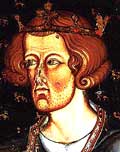| Edward was the eldest son of King Henry III and Eleanor of Provence. In October 1254 he was married to Eleanor (Leonor) of Castile (died 28 Nov 1290). He fought on the side of the king against the rebellious barons and helped his father regain his royal authority by winning the Battle of Evesham (4 Aug 1265) and slaying the barons' leader Simon de Montfort. In August 1270 he went on a crusade to the Holy Land and did not return until 1274. Edward was in Sicily when his father died on 16 Nov 1272, but the royal Council secured taking the oath of fealty by the English bishops and magnates to a new king immediatley after the funeral of Henry III (20 Nov 1272). Confident in his advisers, who assumed the government in England [2], Edward traveled to France, staying several months in Gascony and reaching Dover on 2 Aug 1274. The refusal of Llywelyn ap Gruffydd, Prince of Wales, to attend the king's coronation (19 Aug 1274) and to perform homage provided Edward with a pretext to invade Wales (1277). After a series of military campaigns and the death of Llywelyn (1282), the principality was reorganized according to the Statute of Wales (19 Mar 1284) and submitted to the English crown. In 1286 Edward departed for the continent to reorganize the administration of Gascony and spent three years out of England [3]. In 1290, having systematically stripped the Jews of their wealth, Edward expelled them from England. The parliament summoned by Edward in June 1295 ("Model Parliament") was the first parliament to include representatives of the three estates. Although restricted by the royal authority, parliaments became the distinctive feature of English politics during his reign. With the Statute of Westminster (1275) Edward inaugurated reforms which led, over the next twenty years, to the establishment of a formal parliament.Edward was successful in conquering Scotland and removing to Westminster the coronation stone of Scone (1296). King of Scotland, John Balliol, resigned his kingdom to Edward (2 Jul 1296), who governed it by appointing guardians. In the meantime, Philippe IV of France restored his power in Gascony (1293) and Edward was forced to cross the English Channel and took the field against the French (1297) [4]. However, a guerrilla war in Scotland led by Sir William Wallace forced Edward to return. In winning the Battle of Falkirk (22 Jul 1298), Edward achieved the greatest military triumph of his reign, but he failed to eliminate Scottish opposition. The peace with France, concluded at Montreuil-sur-Mer (19 Jun 1299), was followed by the marriage of Edward to Margaret (Marguerite), sister of Philippe IV (8 Sep 1299). The last years of his reign Edward, named the Hammer of the Scots (Malleus Scotorum) in his epitaph, spent in the warfare against the Scots. He renewed the conquest of Scotland in 1303, captured and executed Wallace (23 Aug 1305), but Robert the Bruce revived rebellion and was crowned at Scone on 25 Mar 1306. Edward led his troops to make another invasion to reconquer Scotland, but he died en route near Carlisle on 7 Jul 1307. [5; 6] |

